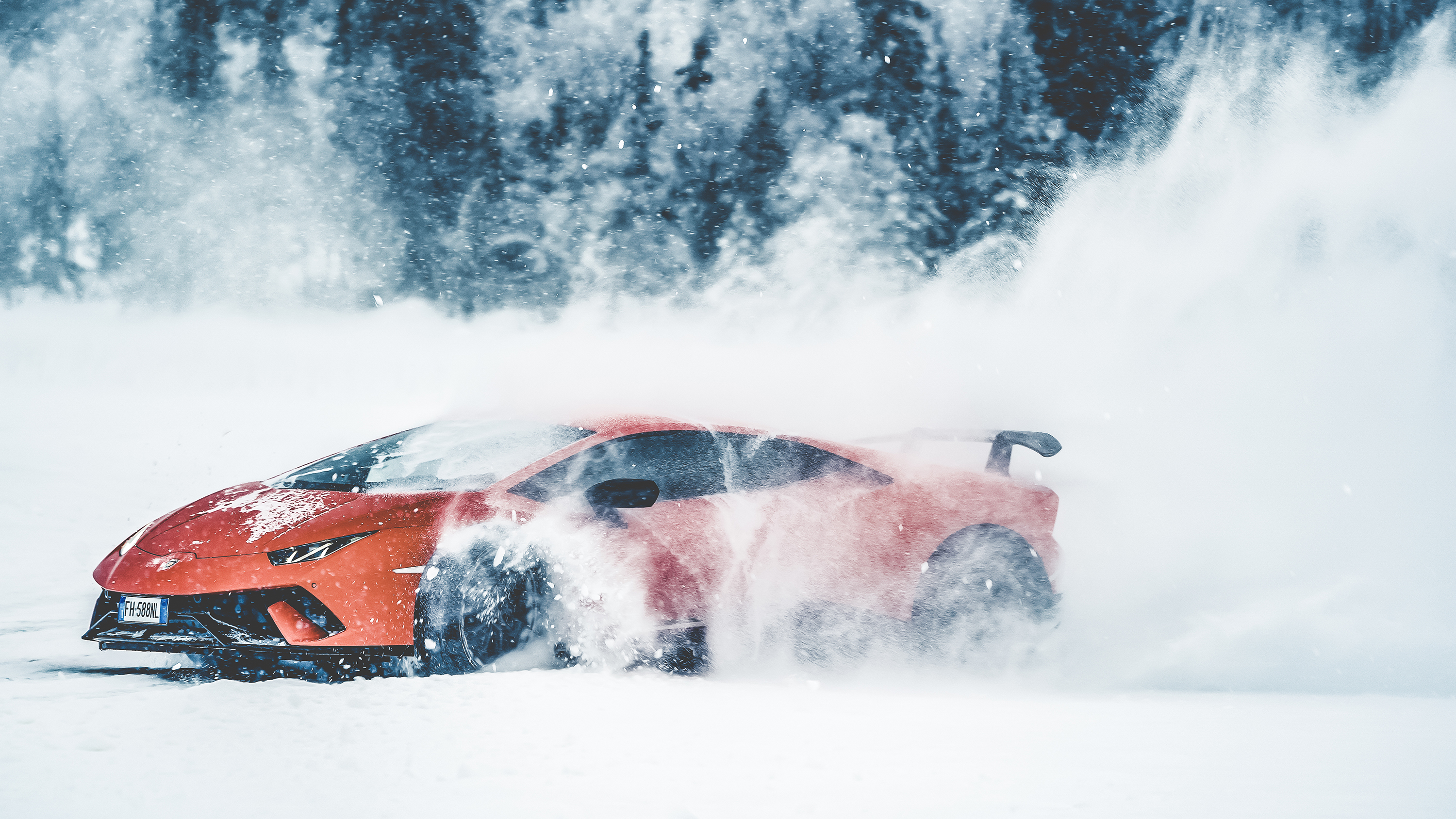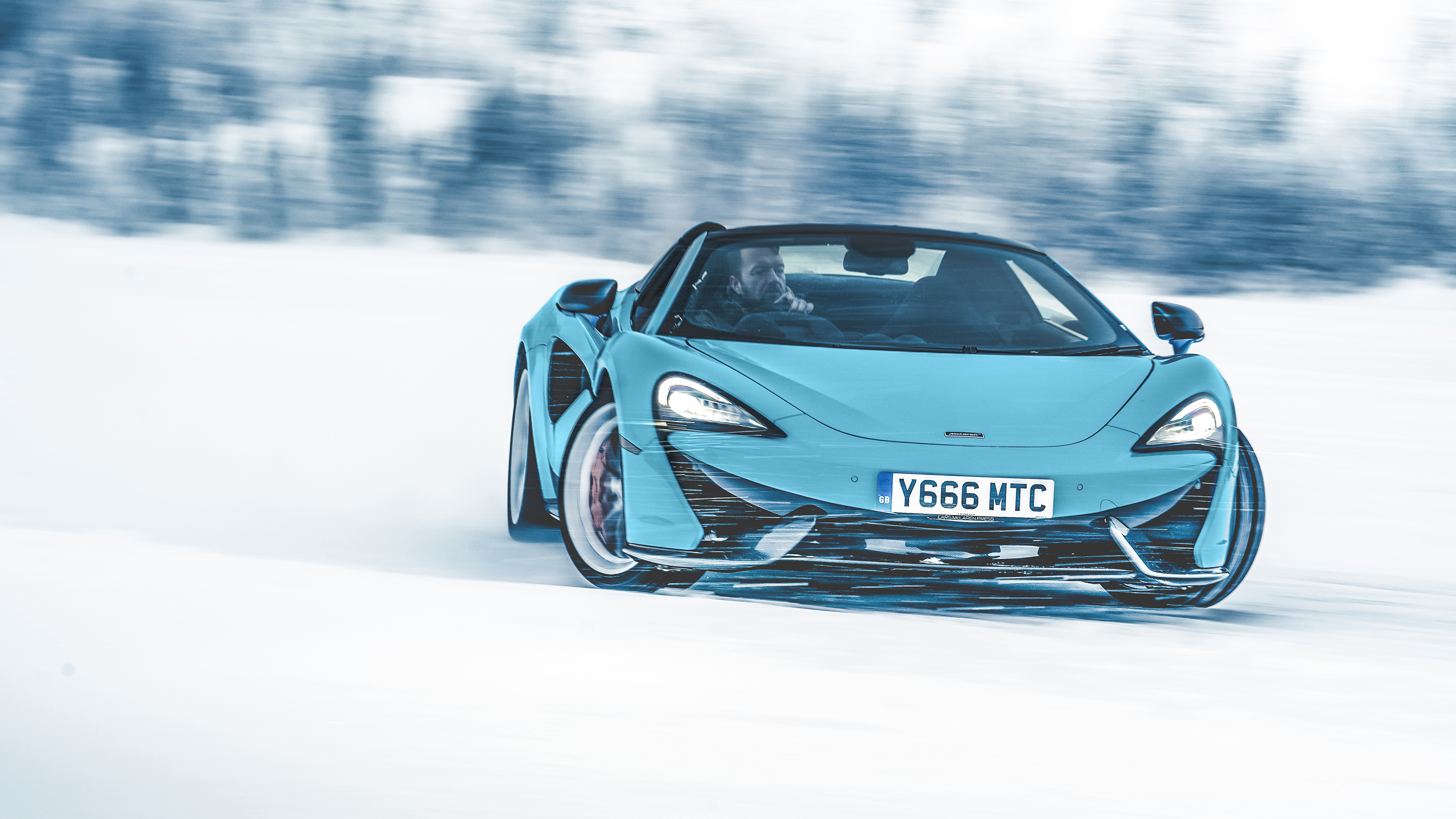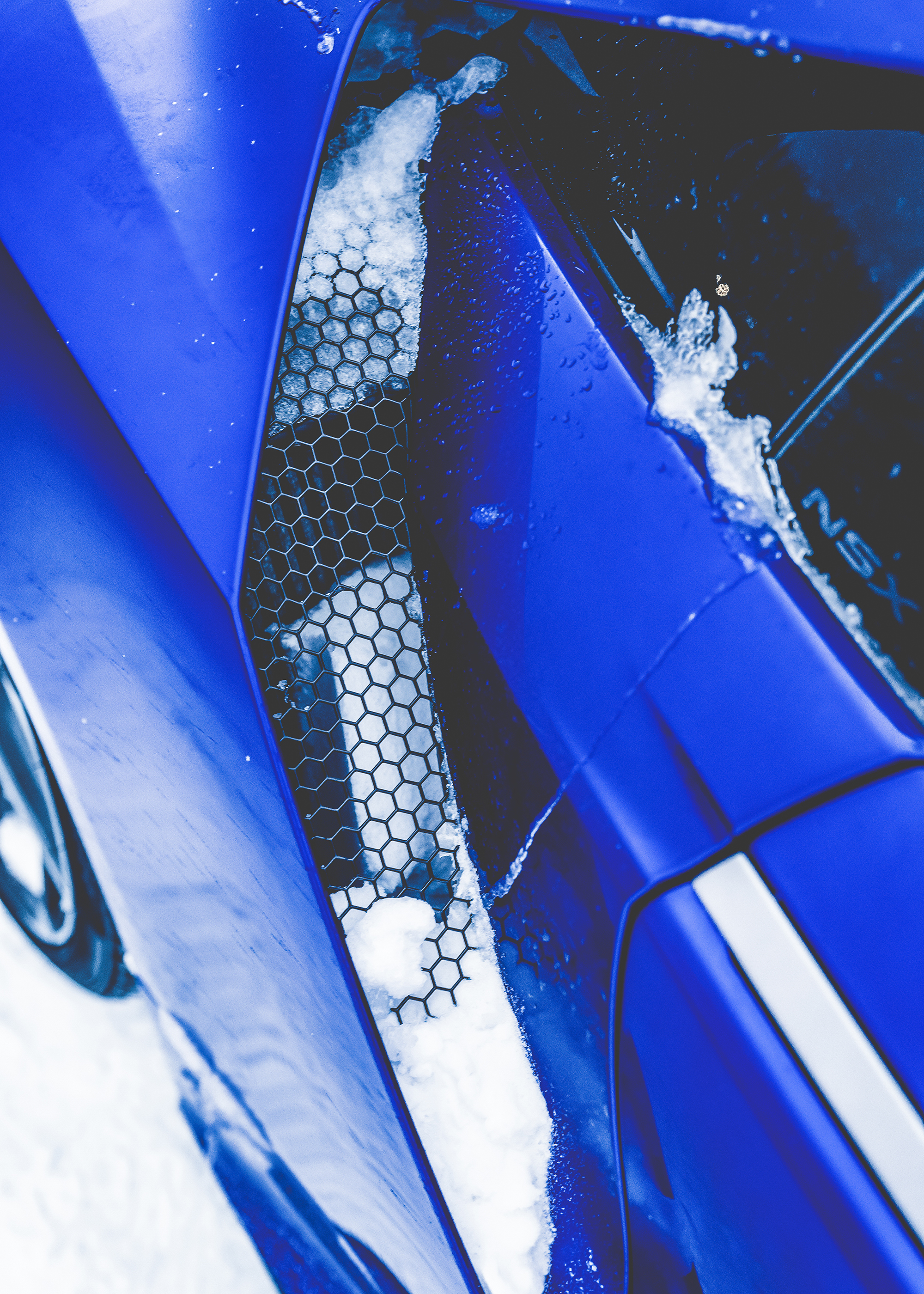
McLaren 570S vs Honda NSX vs Lambo Performante... on ice
Supercars aren't just for Monte Carlo or outside Harrods. They work in minus 20, too
It’s a beastly business, going fast. It’s all serotonin overload, adrenal glands, pumping hearts and throbbing bits. Nerves crackling and eyes that water themselves right through an inability to blink. Fear. Triumph. Aggression. Joy.
It’s a piña colada of excitements gulped direct from your own hormones. And it’s that adrenaline that goes on a murderous rampage through your organs, over-revving biological systems and probably carving a couple of days off your meagre life expectancy with every misjudged braking point.
Words: Tom Ford/Images: Rowan Horncastle and Mark Riccioni
Or at least it is on a road or racetrack. Transfer to an ice lake, and somehow, in the dropping of temperatures and the unclenching of the ability to find traction, it all gets slightly more serene.
Quieter, certainly. Mainly because deploying absolutely everything a car has to offer in terms of power and torque rarely provides extra momentum. Inputs become smaller, brakes get feathered rather than stomped, and speeds drop. Not that it’s a less skilful situation – quite the opposite – but it encourages you to really stretch out your sense of what the car is doing rather than just hanging on.

You start to figure out exactly where a car shifts torque, and when. How deep the biases run front to back, or back to front. You get to feel the vectoring. Which cars rely heavily on their electronics to meter power, and which only use them to rein back. You increase the resolution of sensitivity as you decrease the coefficient of grip, giving a car fewer places to hide.
This I ponder while neatly pirouetting a McLaren 570S Spider at 40mph, having got way too cocky on a long right-hand corner. A full whip-crack 360° which left me facing the right way having spun in my own length, at which point I merely floored it and pretended it was what I intended. This is not the first time I have done this. Everyone knows this is not the first time I have done this, because despite the temperature hovering somewhere around -20°, I have the roof down. Because Spider. Because driving a drop- top supercar on an ice lake demands it.
Up to this point, it has taken me a little while to get a handle on the 570S. Now, some of you might be wondering why we brought a rear-wheel-drive car to battle all-four competition. The answer is simple: because McLarens have demonstrated that their electronic systems have allowed them to out-drag all-wheel-drive cars on dry tarmac, and we wanted to see if that was still the case with very limited traction. And we brought the 570S because it’s a bit friendlier, and because the 720S’s extra 150bhp wouldn’t make a whole heap of difference out here. This has proved to be the case.
And, yes, it’s pretty much impossible not to enjoy the McLaren if you leave the ESC and traction control in their least aware setting. The car will neatly drift and hold an arc with a half-turn of opposite lock casually applied. The steering is transparently excellent and uncorrupted by AWD tugging, and there’s something genuinely pure and exciting about the way it goes about things.

Yes, it feels feather-light at the front, but there’s also something Lotus-ish about the clarity of the messages you get – there’s less going on in terms of delivery, so you’re free to concentrate on throttle balance and grace. It feels light, and chatty, and precise.
Right up until you switch the traction control fully off, and it snaps you backwards with point-one of a millimetre too much throttle. Fine, fine, whoops, tree, tree, backwards, tree, tree, correct direction again. The distance between slide and spin measured by less than the thickness of your socks. A car that feels, at least in part, to have a symbiotic relationship with its electronic systems, rather than using them as a safety net.
The antithesis of the Lamborghini Huracán Performante. Now, obviously the Performante has a little more power than the 570S, but that’s not the point on ice. And neither is the ALA (Aerodinamica Lamborghini Attiva) active-aerodynamic system, which is ineffective at these speeds and refusing to operate anyway – the graphic indicating that the system reckoned it was too cold and had retreated into dormancy.
Top Gear
Newsletter
Thank you for subscribing to our newsletter. Look out for your regular round-up of news, reviews and offers in your inbox.
Get all the latest news, reviews and exclusives, direct to your inbox.
What is the point is the relatively old-school drivetrain: permanent all-wheel drive, locking differentials and natural aspiration. And I know this is a Lambo, and they’re supposed to be scary. Because it’s so fast, and dense, it feels more intimidating. Bigger, somehow. Because you instinctively feel that it might be hard to handle, it gives the car extra fear width.
Don’t believe the hype – this generation of Lamborghinis are not hard to drive. In fact, even though the Corsa mode is great on a race track, it proves a bit clunky on ice, stuttering delivery and stoutly hauling the car into line without the 570S’s more finessed intervention. But when you switch it off... joy.
No, it’s not easy as such – the view is relatively limited, as is the depth of opposite lock you can achieve – but the Huracán is absolutely brilliant without electronic interference. And why? Because it is regular. Predictable. Inherently – almost genetically – bound up in this format. Because the transmission isn’t trying to second-guess the surface, or your inputs, or making a billion calculations per second, it does the same things every time. It breeds confidence. It goes fast, brakes square, stays stable, and is repeatable in a way the McLaren isn’t.
That’s not to say it makes things easy, because it doesn’t – with the surface changing every lap, the Performante required proper concentration, and if you didn’t pay attention to what the front end was telling you, it would nip itself straight, making long slides choppy. The steering is also obviously more corrupted than the McLaren’s, loading and unloading as the front axle apportions torque.
But not unreasonably so. And with that wondrous, sonorous V10 blaring out back, it made heroes of the average. Plus, and it’s a big deal, that engine is naturally aspirated. Which means the delivery is long and sturdily built, rather than a relatively sudden and spin-inducing boost spike. Bluntly, it gives you greater margins of error than the McLaren and allows liberties not only to be taken, but played with.

The NSX on the other hand, was boring in word and deed. Track mode simply made the car paranoid, literally choking the machine down to a benign crawl with brief gasps of incredulity when you tried to prod it into action. The ESC never really disappeared, the clever hybrid system with an electric motor for each of the front wheels vectoring furiously until traction was made beige with its efficacy. It didn’t feel like this on a track last time I drove it.
And then I remembered. The extra-extra ‘off’ bit. Hold the rotary dynamics wheel hard right for a few seconds and get Track Plus. Then hold down the ESC off button for three seconds. And HELLO.
Yes, it may be obnoxiously clever, with a 36bhp electric motor for each front wheel, another assisting the 3.5-litre V6 in the middle and an infinitely broad palette of torque-transferring possibilities, and yes it may be heavy and have ‘only’ 476lb ft even with those battery assists, but that tells you precisely nothing until you’ve driven an NSX all-out and all-off, on ice. Because whoever set this car up for extremis loves driving.
Rear bias? Yep. Front wheels stepping up to drag you straight from the most crashy of sideways angles just at the right time? Yes. Superb, thumping-yet-silken power delivery at any speed range from very low rpm? That too. No, it doesn’t sound like a Lambo, or give you the edge-sweats like the McLaren, but it certainly has you looking good and feeling even better.
At one point, I was crashing in front of a photographer. No excuses. But I had one last desperate throttle-up, and the car pulled itself straight from deep snow. I glanced down and saw 143mph on the speedo, at about 30mph real speed. It. Looked. Glorious.
Better, it was simply great fun. It felt more special dynamically than it looks (although I may have been spoiled a bit by the other two), and the extreme surface managed to coax out the sort of hidden character from the NSX that makes it feel like a proper supercar. It stopped being happily effective and instead unleashed its inner loon. It’s not a cheat-code cure-all, mind, because I did spin it eventually. Turns out the laws of physics are ruthless. Play poker with momentum and see what it does with your bluff.

So what wins? Well, there’s housekeeping first. It is notable that even in dire sub-zero conditions, the Lamborghini never faltered. At all. Yes, it decided that it wasn’t appropriate weather for the active-aero system, but otherwise not a peep. Both NSX and McLaren consistently froze their front brakes solid – necessitating the blowtorch release system – and the Mac had several electronic issues, including ironically refusing to close the roof because it was too cold.
But none of them struggled to get about on their winter rubber – both on the icy, ungritted Swedish roads and the ice lake itself – and none of them felt anything less than utterly capable when trotting about with all systems active. If they can cope with this, they are genuinely all-weather, everyday supercars.
But the McLaren falls first, for me. It’s impressive as hell with the systems playing ball and remarkably adept at maintaining forward motion, but when you switch them off, it turns out it leans on them more than you think. That’s not so much a criticism as a preference, but notable.
The NSX is pretty much the complete opposite of the Lamborghini. One is a hybrid turbo with a huge arsenal of electronic systems; the other a relatively simple, weapons-grade engine/transmission combination. In the NSX, you have to dig a bit to discover the wild side; in the Lamborghini, you come away impressed with the levels of innate, built-in finesse from a car that looks about as benign as an orange knuckleduster. They arrive at the problem with seemingly opposing manifestos, but leave with the same attitude: sideways and laughing.
The Huracán edges it, though. There is something ridiculous, joyously stupid and completely life-affirming about seeing a violently hued, big-winged Lamborghini choompfing through snowdrifts like a speedboat, roaring defiance at the sky. If you’re going to race supercars on ice, it doesn’t get any better than this.
See the rest of Top Gear magazine's Winter Games tests in the latest issue
Trending this week
- Car Review
BMW iX3











